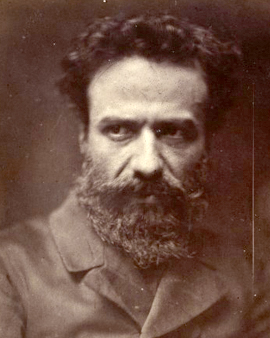Alphonse Legros was a Franco-British painter, etcher and medalist, with close ties to realism. His artistic training began in his home town of Lyon, where he attended the Ecole des Beaux Arts and was a pupil of Maître Nicolardo, a house and portrait painter. Around 1851 Legros moved to Paris to continue his studies there. On the way there he spent about 6 months as a journeyman with the decorator and painter Jean Baptiste Beauchot in Lyon. During this time Legros helped decorate the chapel of Cardinal Bonald. Arriving in Paris, Legros was accepted at the Petite Ecole of Lecoq de Boisbaudran, which would later become the École nationale supérieure des arts décoratifs. There he made the acquaintance of colleagues like Charles-Antoine Cambon, Jules Dalou and Auguste Rodin. Legros also enrolled in evening courses at the École des Beaux-Arts. There he became friends with James McNeill Whistler.
Encouraged by his teachers, Legros first sent two portraits to the Paris Salon in 1857. Only one of them was accepted, the portrait of his father. This was the first public exhibition of his work for Legros. The author Champfleury, who was a great admirer of realism, became aware of the portrait in the Salon and invited Legros to become a member of the realist group around Gustave Courbet. Around the same time Legros began to devote himself increasingly to the art of etching. Two of Legros most famous works were "L'Angelus" and "Ex Voto". After his one-year study trip through Spain he joined the Societé des Aquaforistes in 1863. In later years Legros showed himself to be a supporter of study trips and saw them as an important part of his artistic development. He therefore gave part of his income to supplement a fund to finance such trips for students.
Legros settled in London in 1863 at Whistles' suggestion. There he first gave drawing and etching courses. Later he was accepted as a teacher at the Kensington School of Art. From 1876 he succeeded Edward Poynter as professor at the Slade School. He taught there for over 17 years. Some young female artists, who later became known as Slade Girls, were his students. Among them were the sisters Ella and Nelia Casella, Jessie Mothersole or Elinor Hallé. Legros received British citizenship in 1881. In 1892 he resigned from his professorship and devoted himself to the initial motifs of his work: landscapes, Spanish castles and French farms, as he knew them from his childhood.
×





.jpg)
.jpg)
.jpg)
.jpg)
.jpg)
.jpg)
_-_(MeisterDrucke-1249871).jpg)
_-_(MeisterDrucke-1249871).jpg)
_-_(MeisterDrucke-1643944).jpg)
_-_(MeisterDrucke-1643944).jpg)
_-_(MeisterDrucke-1250843).jpg)
_-_(MeisterDrucke-1250843).jpg)
.jpg)
.jpg)
.jpg)
.jpg)
_-_(MeisterDrucke-1250174).jpg)
_-_(MeisterDrucke-1250174).jpg)
.jpg)
.jpg)
.jpg)
.jpg)
_-_(MeisterDrucke-1264839).jpg)
_-_(MeisterDrucke-1264839).jpg)
.jpg)
.jpg)
.jpg)
.jpg)
_-_(MeisterDrucke-1250231).jpg)
_-_(MeisterDrucke-1250231).jpg)
.jpg)
.jpg)
_-_(MeisterDrucke-1629564).jpg)
_-_(MeisterDrucke-1629564).jpg)
_-_(MeisterDrucke-1255396).jpg)
_-_(MeisterDrucke-1255396).jpg)
.jpg)
.jpg)
.jpg)
.jpg)
_-_(MeisterDrucke-1242957).jpg)
_-_(MeisterDrucke-1242957).jpg)
.jpg)
.jpg)
.jpg)
.jpg)
.jpg)
.jpg)
.jpg)
.jpg)
.jpg)
.jpg)
_(see_also_414599)_-_(MeisterDrucke-84195).jpg)
_(see_also_414599)_-_(MeisterDrucke-84195).jpg)
.jpg)
.jpg)
.jpg)
.jpg)
_-_(MeisterDrucke-1248882).jpg)
_-_(MeisterDrucke-1248882).jpg)
.jpg)
.jpg)
_-_(MeisterDrucke-1245983).jpg)
_-_(MeisterDrucke-1245983).jpg)
_-_(MeisterDrucke-1335660).jpg)
_-_(MeisterDrucke-1335660).jpg)
.jpg)
.jpg)
.jpg)
.jpg)
.jpg)
.jpg)
.jpg)
.jpg)
.jpg)
.jpg)
_-_(MeisterDrucke-1252531).jpg)
_-_(MeisterDrucke-1252531).jpg)
_-_(MeisterDrucke-1241455).jpg)
_-_(MeisterDrucke-1241455).jpg)
.jpg)
.jpg)
.jpg)
.jpg)
.jpg)
.jpg)
_-_(MeisterDrucke-1255001).jpg)
_-_(MeisterDrucke-1255001).jpg)
_-_(MeisterDrucke-1252392).jpg)
_-_(MeisterDrucke-1252392).jpg)
.jpg)
.jpg)
.jpg)
.jpg)
_-_(MeisterDrucke-1267016).jpg)
_-_(MeisterDrucke-1267016).jpg)
.jpg)
.jpg)
.jpg)
.jpg)
.jpg)
.jpg)
.jpg)
.jpg)
.jpg)
.jpg)
.jpg)
.jpg)
.jpg)
.jpg)
.jpg)
.jpg)
_-_(MeisterDrucke-1254116).jpg)
_-_(MeisterDrucke-1254116).jpg)
_-_(MeisterDrucke-1249859).jpg)
_-_(MeisterDrucke-1249859).jpg)
.jpg)
.jpg)
.jpg)
.jpg)
.jpg)
.jpg)
.jpg)
.jpg)
_-_(MeisterDrucke-1240749).jpg)
_-_(MeisterDrucke-1240749).jpg)
.jpg)
.jpg)
.jpg)
.jpg)
.jpg)
.jpg)
_-_(MeisterDrucke-1253046).jpg)
_-_(MeisterDrucke-1253046).jpg)
.jpg)
.jpg)
_-_(MeisterDrucke-1334915).jpg)
_-_(MeisterDrucke-1334915).jpg)
_-_(MeisterDrucke-1369224).jpg)
_-_(MeisterDrucke-1369224).jpg)
.jpg)
.jpg)
_-_(MeisterDrucke-1251528).jpg)
_-_(MeisterDrucke-1251528).jpg)
_-_(MeisterDrucke-1267004).jpg)
_-_(MeisterDrucke-1267004).jpg)
.jpg)
.jpg)
_-_(MeisterDrucke-1251819).jpg)
_-_(MeisterDrucke-1251819).jpg)
.jpg)
.jpg)
_-_(MeisterDrucke-1629415).jpg)
_-_(MeisterDrucke-1629415).jpg)
_-_(MeisterDrucke-1250273).jpg)
_-_(MeisterDrucke-1250273).jpg)
.jpg)
.jpg)
_-_(MeisterDrucke-1247756).jpg)
_-_(MeisterDrucke-1247756).jpg)
.jpg)
.jpg)
.jpg)
.jpg)
.jpg)
.jpg)
.jpg)
.jpg)
.jpg)
.jpg)
.jpg)
.jpg)
.jpg)
.jpg)
_-_(MeisterDrucke-1242597).jpg)
_-_(MeisterDrucke-1242597).jpg)
_gathering_in_front_of_an_ex_-_(MeisterDrucke-950633).jpg)
_gathering_in_front_of_an_ex_-_(MeisterDrucke-950633).jpg)
_-_(MeisterDrucke-1252830).jpg)
_-_(MeisterDrucke-1252830).jpg)
_-_(MeisterDrucke-1246116).jpg)
_-_(MeisterDrucke-1246116).jpg)
.jpg)
.jpg)
_-_(MeisterDrucke-1245086).jpg)
_-_(MeisterDrucke-1245086).jpg)
.jpg)
.jpg)
_-_(MeisterDrucke-1243738).jpg)
_-_(MeisterDrucke-1243738).jpg)
 - (MeisterDrucke-70078).jpg)
 - (MeisterDrucke-70078).jpg)
.jpg)
.jpg)
.jpg)
.jpg)
.jpg)
.jpg)
.jpg)
.jpg)






